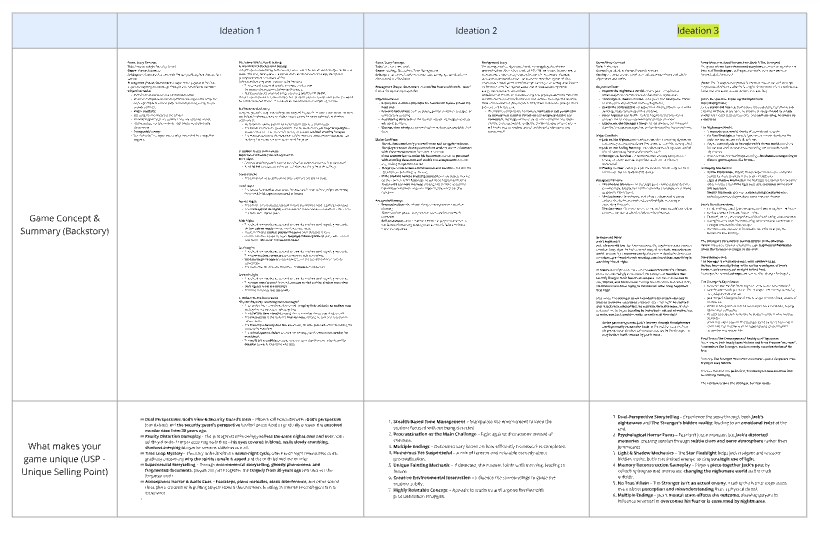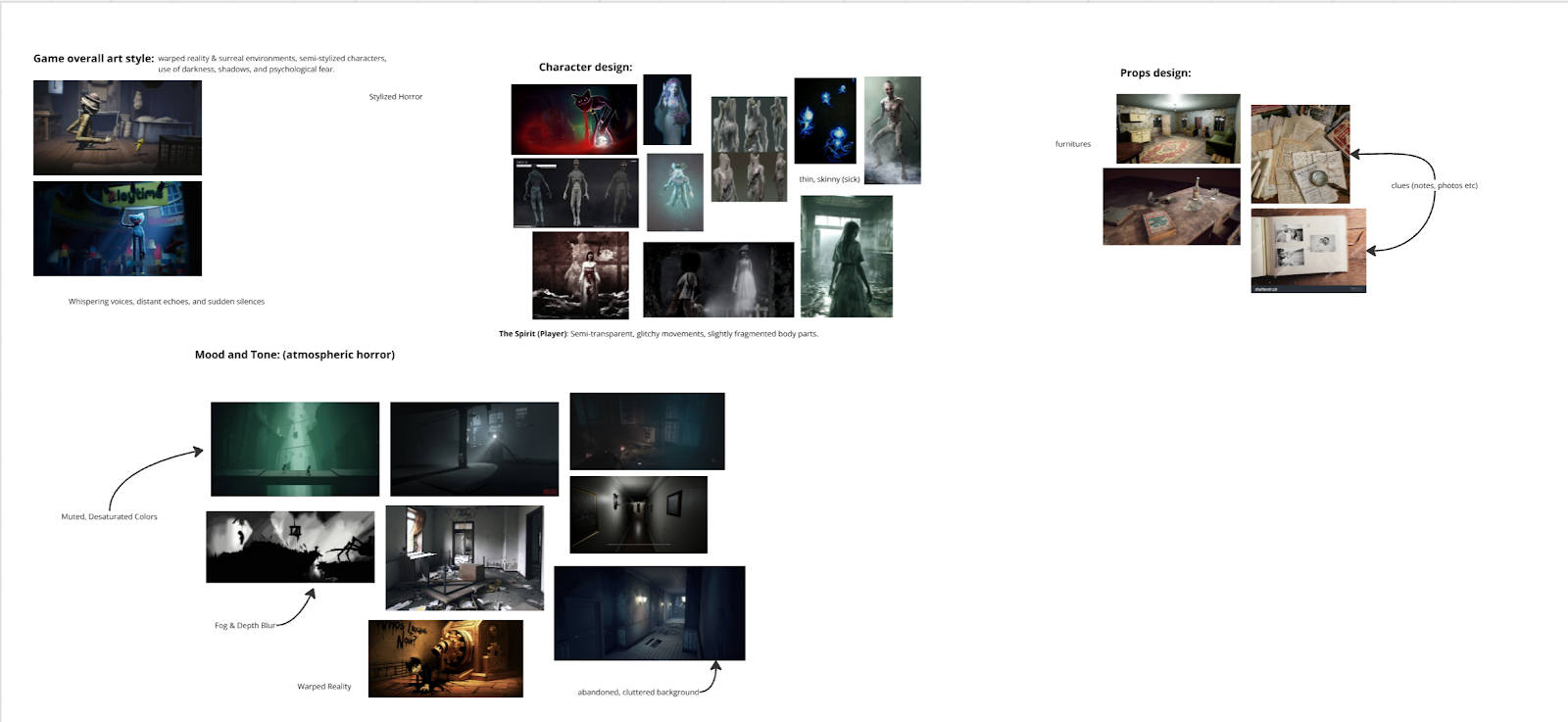MAJOR PROJECT 1/ TASK 1, 2 & 3
03.02.2025 - 23.03.2025 (Week 1 - Week 7)
TAN JIE YING / 0353959 / BACHELOR IN DESIGN OF CREATIVE MEDIA
MAJOR PROJECT 1
TASK 1, 2 & 3
INSTRUCTIONS
Miro Board
Task 1: Proposal Development This stage required us to make a proposal to introduce the concept of our project.
Progress
Week 1
We form a group of 4 members:
- Tan Jie Ying (Me) - Animation
- Kelly Lau Jie Ning - Animation
- Bernice Ting Wen Yi - Entertainment (Group Leader)
- Tan Ying Yi - Entertainment
Since we have two entertainment design students, we decided to create a game concept. We chose to develop a horror game and then identified our game genre and theme.
After finalizing the game genre and theme, we researched and gathered a few references for inspiration.
Enigmatis: The Mists of Ravenwood 2 is a hidden-object puzzle game where players solve mysteries by finding clues and uncovering secrets in a dark, eerie setting.
Go Home is a psychological horror game where a young girl must escape supernatural threats while finding her way home.
After completing our research, we began brainstorming our game story. Based on our findings, each of us developed three different story ideas aligned with the game concept, summarizing them along with their unique selling points.
Week 2
During the consultation, our lecturer suggested combining our ideas. After discussing it, we decided to use Bernice's story and further developed it together.
Story Explanation:
Velum is a psychological horror game where you play as a vengeful spirit, uncovering memories while using supernatural pranks to scare your brother. Choose to reveal the truth for reconciliation or fuel his fear for revenge. With exploration, puzzles, and paranormal interactions, your choices shape the final outcome.
Meanwhile, since we wanted a style similar to Poppy Playtime and Little Nightmares, we gathered references for art style, character design, environment, and props based on these styles.
Our leader assigned various roles and responsibilities for us to choose from. Each of us selected at least three positions that we felt suited our skills.
Timeline
To keep us on track each week, our leader created a clear timeline to ensure continuous progress on our tasks.
Week 3
As the story was finalized, we began working on the storyboard to visualize it.
Following the mood board, we sketched several designs for the main character, emphasizing a skinny and sickly appearance to reflect her passing from illness.
To gain more detailed inspiration that aligns with our envisioned scenes and characters, we searched for additional references.
Our setting is a two-story European-style house. Based on this, each of us sketched our own floor plan ideas.
Final Outcome
Task 2: Design Proposition In this stage, we will finalize our designs and conduct testing on the apps that will be used.
Progress
Week 4 Kelly and I are researching the apps we can use for our project. We are listing the apps we can use and also exploring new websites and apps for animation.
Week 5 - 6 We have started testing some of the apps. Kelly is in charge of rigging using 3ds Max, while I am in charge of testing the Mixamo and Adobe Substance Painter.
Mixamo is an Adobe modeling website that helps rig human characters. However, its disadvantages include the inability to adjust animation actions, long wait times for character imports, and a limited selection of available actions.
Substance Painter is an app that helps paint your 3D model. It provides a variety of materials for you to choose from.
I encountered a problem when exporting the file from Blender to Substance Painter—the model does not appear in separate layers; instead, it merges into one layer.
Figure 5.4 Adobe Substance Painter Testing
Due to the due date, after testing I move on to the Slides and Gantt Chart.
Bernice and I listed the tasks we completed previously. To help Kelly plot the tasks on the timeline, I provided the specific dates, while Kelly assigned colors based on the process timing.
Gantt Chart
Final Outcome
Task 3: Concept Presentation This presentation is to see our development from task 1 to task 2.
Progress
As the final week of the semester approached, we needed to present our progress from Task 1 to Task 2. Unfortunately, Kelly and Ying Yi were busy, so with limited time, Bernice and I decided to move forward instead of waiting. Together, we worked on completing the presentation slides.
The final presentation was intended to showcase our development process, including mood boards, character sketches, explorations, testing, and refinements, in a clear and structured manner.
Due to the limited time, we focused on making the slides clean and visually organized for easy understanding, ensuring they didn’t feel boring with too much text. Although we were rushing, we managed to compile and finalize the slides on time for the presentation.
Final Outcome
FEEDBACK
- Before starting identify clearly the game genre and theme.
- Find more references for the environment, characters, and props from Poppy Playtime and Little Nightmares.
- Try testing the project in applications like Unreal Engine, Unity, Blender, or other relevant software to see how it functions and performs.
- Identify the target platform, such as mobile, PC, or others. This will help determine the appropriate screen size and optimize the design accordingly.
- Summarise your story everytime while you present it to your client make it short and understanding.
- The design can be more stylish—for example, adjust the table like in a cartoon, with some parts big and some parts small. This will make it more interesting instead of having everything in a fixed model.
- In the game, unnecessary details can be simplified if players don't interact with them. For example, if players only flick books on a shelf without picking them up, there's no need to model each book in detail.
- Test the overall environment using blocks or simple shapes for the room and evaluate the spacing.
- Start testing using the apps, no need to be to advance a rough one is enough.
- Learn UV mapping in Blender to properly separate layers for use in Substance Painter.
- The testing is not enough.
- The biggest issue right now is file transfer, as we are using Unreal Engine for the final project. Test importing animation files from Blender, Maya, or 3ds Max to see if they work properly. Due to differences between software, issues like time discrepancies, misalignment, or import errors may occur.
- Design the characters in illustration.
REFLECTIONS
Since we come from different specializations, I was initially worried that communication within our group would be challenging. However, we worked effectively as a team—everyone understood the concept and their assigned tasks. Even when we had different ideas and perspectives, we maintained good communication during discussions, especially after receiving feedback and during meetings.
To ensure we stayed on the same page, we frequently held meetings and discussions to review our progress and plan our next steps. Since Bernice and Ying Yi are entertainment students with strong skills in sketching, we decided that Bernice would take charge of character design while Ying Yi focused on the environment. Meanwhile, Kelly and I explored and learned new software that could be useful for our project.
However, due to tight deadlines and other module assignments, we found ourselves in a rushed period. On top of that, we were only informed about our Task 3 presentation a day before we had to present, while I also had another assignment to complete at the same time. With all of us rushing, we faced challenges in communication and discussion, which made the process even more difficult.
These seven weeks have been tough—creating a game concept was far more challenging than I initially expected. As I am not an entertainment student, I had to learn many aspects of game design, including Unreal Engine, 3ds Max, Maya, and more, which I had never used before. Due to time constraints, I wasn’t able to fully explore these software tools, including Unreal Engine, 3ds Max, and Substance Painter.
Although the semester has ended, there are still many aspects that need further testing. I plan to continue experimenting and refining my skills before we begin our Major Project 2.
.jpg)





















.jpg)
.jpg)
Comments
Post a Comment